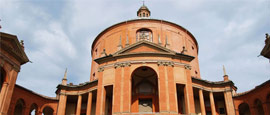Taking its names from Bologna's patron saint, this is the fifth largest basilica in the world. The church is unfinished because it was originally intended to be larger than St Peter's in Rome until the Pope halted construction. Armed guards linger outside because a fresco by Giovanni di Modena depicts Muhammad in hell.
Things to see in Bologna
Tourist offices
Address: Piazza Maggiore, 1, Bologna, 40124, Italy
Tel: +39 51 239 660.
Opening Hours:Mon-Sat 0900-1900, Sun 1000-1700. www.bolognawelcome.com
Bologna Welcome can book hotels, tours and excursions. It also sells theatre and event tickets. There is a second location at Bologna Guglielmo Marconi Airport.
Available online or from Bologna Welcome, the 48-hour Bologna Welcome Card (www.bolognawelcome.com/en/richiedicard) allows free admission to a wide choice of sights including those in the Genus Bononiae itinerary such as San Giorgio in Poggiale and Palazzo Pepoli. The holder can also get into the permanent collections of the municipal museums for nothing. The owner also get free transport for 24 hours, an airport transfer, Wi-Fi in the city and discounts and special offers on nightlife, shopping, restaurants, spas and leisure activities.
The Basilica di St Stefano is a jumbled complex of interconnecting churches, cloisters, courtyards and crypts. There were once seven churches here, now there are a mere four. The bulk of the building, including the city's oldest church, San Vitale e Agricola, dates from the 5th century.
This 16th-century fountain, the work of Flemish sculptor Giambologna, is the central meeting place in Bologna. When it is lit at night, the shadow of the mighty bronze Neptune looms across the piazza, his trident clasped firmly in his left hand and a fish squirming beneath his foot.
Housed in an old 15th-century mortuary, this superb museum contains one of Italy's most important collections of Egyptian artefacts, including a splendid cycle of bas-reliefs from the tomb of Horemheb. Its Roman section is also first rate, but the museum is best known for having one of the finest Etruscan collections outside Lazio.
The church of San Domenico, consecrated in 1251, was built to house the relics of St Dominic, the founder of the Dominican Order. The basilica holds several precious works of art such as paintings by Guercino, Filippino Lippi and Pisano, plus an angel carved by Michelangelo. Its wooden choir is a Renaissance masterpiece.
Leaning precariously like a couple of proud old dowagers, the Asinelli and the Garisenda towers are among the city's most recognisable landmarks. In the 12th and 13th centuries, the noble families of Bologna raised over 100 towers across the city in successive attempts to outdo each other. Of the 20 that remain, these are the most revered. Only the Asinelli Tower is accessible.
Bologna was the second city inside the Papal States to force Jews to live in a particular area and this museum, located in that very ghetto, explores the greater Jewish identity and its place within the Emilia Romagna region. Its materials link to the synagogue of Modena and the Jewish Museums of Soragna and Ferrara.
The National Gallery celebrates the city's artistic and spiritual past from the 14th to the 16th century. There are some fine examples of works by fathers of baroque Guido Reni and the Carracci brothers. Deeply influenced by the Counter Reformation that was sweeping the country, the paintings are highly emotionally charged and deeply religious. Among the Italian old masters, Raphael's Ecstasy of St Cecilia and El Greco's Last Supper should not be missed.
The route to this wonderful basilica church outshines the sanctuary itself: a 3.5km (2 mile) portico of 666 arches alternating with 15 chapels, built between 1674 and 1793 to protect the icon as it was paraded up and down the hill. It's the longest portico of its kind in the world.
This remarkable 17th-century operating theatre is where Bologna’s gentry would pay to watch the world's first public dissections. An Inquisition priest would sit in on all operations to ensure proceedings were spiritually acceptable. Damaged in WWII, the theatre has since been rebuilt.
Do you have any Feedback about this page?
© 2025 Columbus Travel Media Ltd. All rights reserved. No part of this site may be reproduced without our written permission, click here for information on Columbus Content Solutions.








 You know where
You know where